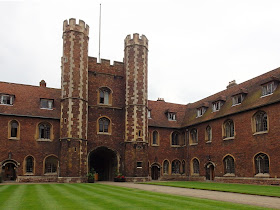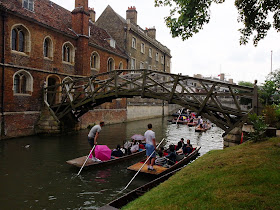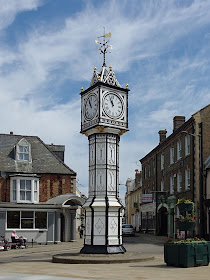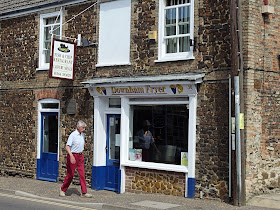They get very sniffy about that apostrophe so I'd better get it right.
Queens' College, unlike neighbouring King's, does not announce itself to the casual visitor. King's strides grandly and majestically along King's Parade and has the wonderful Chapel which, with both its size and magnificence, dominates the scene. Queens' College, in contrast, hides away demurely in a side street. You enter through what appears to be just a hole in a drab and grimy wall, though once inside you turn to see that you've actually come in through a mighty gatehouse.
The street outside is so narrow and cramped that you are scarcely able to see the whole building. The college was founded in 1448 by Queen Margaret of Anjou, wife of Henry VI, as The Queen's College of St Margaret and St Bernard to "laude and honneurre of sexe feminine". Then in 1475 the college was re-founded by Elizabeth, the Queen of Edward IV. So the college was founded by two queens, hence that apostrophe after the "s".
The Old Court, which you see as you first enter is little changed since it was built when the college was founded. As you make your way through the archway into Cloister Court you are able to see into the Old Hall.
How very different from the canteen where I ate my sausage and chips when I was a student! Originally the Hall was rather plain but was re-decorated in the mid-19th century in the Arts and Crafts style.
Then you're in Cloister Court itself. If Queens' lacks the grandeur and extravagance of some other colleges then it more than makes up for it with the quirky charm exhibited here:
From Cloister Court you can sneak through the corner into Walnut Tree Court....
....along one side of which stands the New Chapel (by "New" we mean 1891) which was designed, like the re-decorations which we saw in the Hall, by George Bodley. Avid readers of this blog, if any such there be, might remember Mr Bodley from a post about All Saints' Church; well, here's some more of his work....
There was preparation going on for some kind of end of college-year event so I didn't investigate further, but made my way around to where there was a more relaxed feel to proceedings in the Fellows' Garden....
....I say, old boy, are you sure those are Fellows? They look like "the sexe feminine" to me.
I wandered back into Cloister Court to cross the river by The Wooden Bridge, or the Mathematical Bridge as it's more often, but incorrectly, known.
I've shown you this before but to save the muscles of your clicking-finger here's what I said then:
"If you've been to Cambridge you've probably seen this queer-looking bridge. It's the kind of structure that seems to inspire stories. The college authorities refer to it as "The Wooden Bridge" but everyone else calls it the "Mathematical Bridge". Some say it was designed by Isaac Newton but in fact it was the work of an undergraduate named W. Etheridge in 1749. Disappointing but true. Then you may hear that it was originally held together without the need for nails or bolts. That may be true but wooden dowels were probably used instead. The last tale, and the one I really wish was true, is that the iron bolts were put in because inebriated students returning after a night in the local alehouses could not resist the temptation to dismantle the bridge. Then of course, in the cold light of day, they found it was much harder to put back together again. But sadly there's no evidence for that story either."
Over on this side of The Cam the college has added some more modern buildings, built in the 1970s and 80s; not bad for their day, but not in keeping with our present post. So lets just take a wordless wander back the way we came...
Take care.
Pages
▼
Sunday, 29 June 2014
Friday, 27 June 2014
Don't Forget Your Greens!
Don't forget your greens! How many mothers have told their children that?
And yesterday wandering through the Botanic Gardens in Cambridge I consumed as many greens as I could find, ignoring all the tastier colours that were on offer.
So I now offer them to you. It won't count as one of your "five a day", but I hope it won't give you indigestion either.
And yesterday wandering through the Botanic Gardens in Cambridge I consumed as many greens as I could find, ignoring all the tastier colours that were on offer.
So I now offer them to you. It won't count as one of your "five a day", but I hope it won't give you indigestion either.
Everything seems super-luxuriant this year,
the result of an early spring and just enough rain an sun.
Just a few cones still hanging on.
Cheating a little bit;
those leaves are almost red.
Mrs Moorhen on her nest in the Fen Garden.
Yes, that's what the Fens looked like before they were drained!
The architectural design of seed pods.
The Winter Garden looks pretty good in summer too.
An almost sci-fi look.
These bracket fungi have released vast amounts of spores
giving the ivy a rusty appearance.
Alien forms again!
Is it just me or does that picture look 3D?
Especially centre-bottom where, incidentally, there's an almost transparent insect.
The palest of pale greens.
At the water's edge.
Take care.
Wednesday, 25 June 2014
Questions And Answers
As I cycle or walk around the countryside I find all sorts of odd objects, some of which pose questions while others provide answers.
Biking Country
Fenland and much of East Anglia is prime motorbiking country and many bike racers hail from the area. In Littleport there stands this monument to Harley-Davidson motorcycles. William Harley emigrated from the town in 1865, fought in the American Civil War and later fathered several children, one of whom, William Sylvester Harley, co-founded the motorcycle company with Arthur Davidson in 1903. I know what someone's going to ask and the answer is "Yes....
....of course!"
Faithful Servants
In Trumpington churchyard I spotted this interesting old stone. The inscription tells us
Biking Country
Fenland and much of East Anglia is prime motorbiking country and many bike racers hail from the area. In Littleport there stands this monument to Harley-Davidson motorcycles. William Harley emigrated from the town in 1865, fought in the American Civil War and later fathered several children, one of whom, William Sylvester Harley, co-founded the motorcycle company with Arthur Davidson in 1903. I know what someone's going to ask and the answer is "Yes....
....of course!"
Faithful Servants
In Trumpington churchyard I spotted this interesting old stone. The inscription tells us
I M O
TWO FAITHFUL AND VALUED SERVANTS
SYLVIA VIGOR
WHO WAS BURIED FEB 3, 1867
AND
HADNEY ANTHONY TOLEMAN
COMMONLY KNOWN AS JAMES TOLEMAN
WHO WAS BURIED DEC 31 1872
BOTH LIVED UPWARDS OF 50 YEARS
IN THE FAMILY
OF THE LATE COL. AND MRS. PEMBERTON
WHOSE DAUGHTER ERECTS THIS
MEMORIAL
Sylvia Vigor was the housekeeper for the Pemberton family at Trumpington Hall while James Toleman was the butler. It is known that Toleman was given the job of bringing the body of F C J Pemberton back from France when he died in 1849. What is not known (and what all of you who tune in to Downton Abbey want to know) is what the relationship was between Mr Toleman and Miss Vigor during their lifetimes.
Fire Fighters
Before the days of a regular organised fire brigade many towns and villages had their own volunteer fire fighters. In some villages the old brigades are remembered by an old Engine House, like this one in Thaxted. But this time the question is "What sort of fire-engine would they have housed?" In Thaxted the answer can be found in the museum at the old windmill.
Some Unlikely Addresses
How would you like to live here? North American readers should substitute "Moochers Lane" to get the full meaning while those in Australia should consider what it might be like to live in "Bludgers Lane". In other words it's someone who asks for and obtains something to which they are not entitled. But "cadger" originally meant nothing more sinister than "itinerant trader" and this lane is where they set up their stalls. But how about....
This time it just happens to be in Devil's Alley, a street in King's Lynn where it is said the footprint of the devil can be seen on the stone street. Maybe, but I couldn't see it.
And finally some comforting news on this name-plaque....
'Nuff said!
Take care.
Take care.
Sunday, 22 June 2014
At The Edge Of The Known World
Thornham harbour,
At the edge of the known world.
At the edge of the known world.
Here come Fishbait and Crabbucket,
two boys half-grown,
the salty wind tugging at their mud-matted hair.
It's a June-day afternoon,
any time in the last few centuries.
any time in the last few centuries.
Fishbait scans the blurred horizon
Watches for fisherboats from the rickety jetty
Watches for fisherboats from the rickety jetty
And practises his knots and hitches,
Legs dangling in the uncertain breeze.
Legs dangling in the uncertain breeze.
Crabbucket doesn't care.
Crabbucket squelches down to the water's edge
In the here and now of an eternal summer's day.
Doesn't know about yesterday.
Doesn't care about tomorrow.
Behind them the village stands on solid ground,
Square-built with flint walls and red rooftiles.
Place of elderly gardeners and maiden aunts,
Given the slip by half-grown boys
Who hide out, pirate-fashion, among the creeks and mudhollows.
Square-built with flint walls and red rooftiles.
Place of elderly gardeners and maiden aunts,
Given the slip by half-grown boys
Who hide out, pirate-fashion, among the creeks and mudhollows.
The sea murmurs and slurs, restless and unfathomable.
Fishbait dreams of boats and tides,
Of sandbanks and deepwater channels.
Fishbait in his sea-captain's cap.
Here where land and sea dispute reality
Crabbucket flushes the panicky Redshank
As he bumbles through the drowsy Sea Lavender
Looking for mythic treasure.
Two boys half-grown
With a precarious toe-hold
On the cormorant-black mudslime
At the edge of the known world.
With a precarious toe-hold
On the cormorant-black mudslime
At the edge of the known world.
Take care.
Saturday, 21 June 2014
In Downham Market
The Clock Tower
The splendid Victorian clock tower was presented to the town by local draper James Scott in 1878. It has become something of a symbol of the market town and, unusually, it originally had its dial lit from within by gas.
A Candid Camera At The Market
And Some Interesting Buildings
The local fish 'n' chip shop is one of many buildings built of the local carrstone which give the town the nickname of "Gingerbread Town".
This rather run-down TV shop grabbed my attention with its overcrowded facade, however it also has a few interesting architectural features which result from its former use as a pub.
A row of colourful cottages such as one finds in many East Anglian market towns, I presume the one with the big window used to be a shop.
The rather eye-catching architecture of the Castle Hotel which dates from the eighteenth century. It stands on the corner of Paradise Road which is said to have been the site of the gallows in former times - it was reckoned to be the nearest to Paradise that they would ever get!
The Railway Station
The signal box which stands next to the station is one of 26 nationwide which are listed for preservation; automated systems are making most of them redundant.
The station also retains its marvellous waiting-room where you can wait in comfort should the train from King's Lynn be delayed. Not only that but....
.....there's a quaint old bar where you can get a pint. Like the waiting-room it has an atmosphere of the nineteen-forties. Unfortunately my train was on time!
Take care.
The splendid Victorian clock tower was presented to the town by local draper James Scott in 1878. It has become something of a symbol of the market town and, unusually, it originally had its dial lit from within by gas.
A Candid Camera At The Market
And Some Interesting Buildings
The local fish 'n' chip shop is one of many buildings built of the local carrstone which give the town the nickname of "Gingerbread Town".
This rather run-down TV shop grabbed my attention with its overcrowded facade, however it also has a few interesting architectural features which result from its former use as a pub.
A row of colourful cottages such as one finds in many East Anglian market towns, I presume the one with the big window used to be a shop.
The rather eye-catching architecture of the Castle Hotel which dates from the eighteenth century. It stands on the corner of Paradise Road which is said to have been the site of the gallows in former times - it was reckoned to be the nearest to Paradise that they would ever get!
The Railway Station
The signal box which stands next to the station is one of 26 nationwide which are listed for preservation; automated systems are making most of them redundant.
The station also retains its marvellous waiting-room where you can wait in comfort should the train from King's Lynn be delayed. Not only that but....
.....there's a quaint old bar where you can get a pint. Like the waiting-room it has an atmosphere of the nineteen-forties. Unfortunately my train was on time!
Take care.



























































